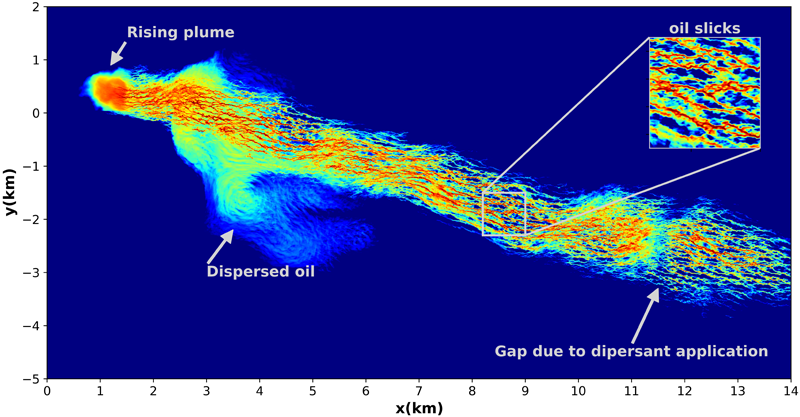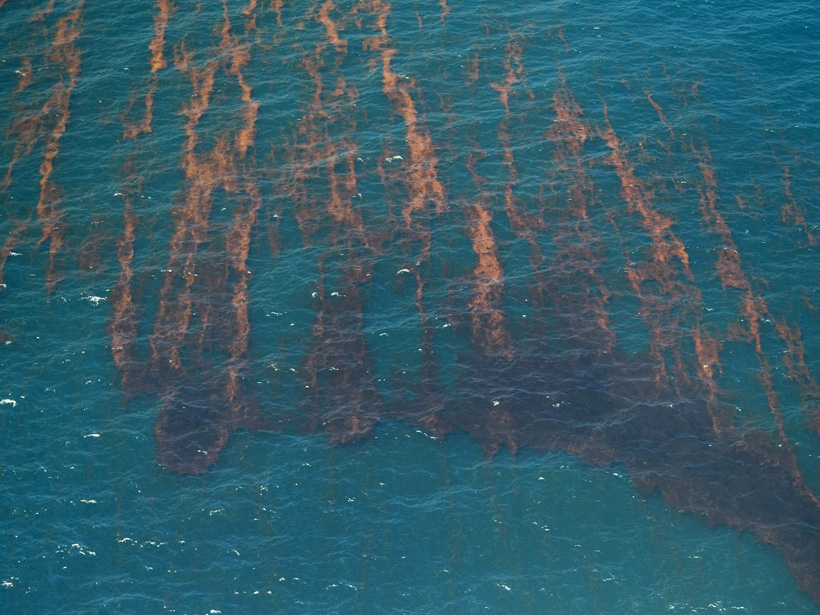The upper layer of the ocean is known as the “ocean mixed layer” (OML). Although usually just a few tens of meters deep, it’s very influential in mediating the exchange of gases, momentum, and energy between the interior of the ocean and the atmosphere. As such, it also has a direct impact on the Earth’s climate. A recent article in Reviews of Geophysics explored how different natural and anthropogenic materials are transported around the OML and described the new insights that computer simulations have brought to our understanding of this movement. Here, the authors explain what happens in the OML, why it’s important, and what is yet to be fully understood.
What are the main characteristics of the “ocean mixed layer”?
The defining characteristic of the OML is its high level of mixing, which is promoted by the presence of small-scale three-dimensional turbulence. The turbulent mixing is driven by varying levels of wind shear and cooling at the surface, and is modulated and enhanced by surface waves (both breaking and non-breaking), resulting in the nearly uniform distribution of temperature, salinity, density, and nutrients with depth within the OML.
Another important characteristic is the appreciable variation in flow speed and direction with depth produced by the effects of the Earth’s rotation. This vertical structure of the flow is usually termed the Ekman spiral (despite differences between the classic mathematical solution obtained by Ekman in 1905 and the observed profiles in the real ocean), and it has important consequences for material transport.

What kind of materials move around in this part of the ocean?
Materials in the OML can be divided into those that are naturally occurring (e.g. gas bubbles, plankton, and nutrients) and anthropogenic (e.g. microplastics and oil).
Plankton and nutrients are generally neutrally buoyant in saltwater, which means they are usually well-mixed within the OML, but gas bubbles, oil droplets, and microplastics are positively buoyant and tend to accumulate near the surface. There is a competition between buoyancy and turbulent mixing, and these materials can only be well-mixed if turbulence is strong enough. In addition, buoyant materials respond very differently to the flow eddying motion, producing complex spatial patterns in their horizontal and vertical distributions. These patterns can be seen in in pictures of oils slick on the ocean surface, such as the one from the Deepwater Horizon spill in 2010 shown above.
In the case of human-made materials, it is particularly important to determine how they move around in order to understand their impacts on ecosystem health and develop pollution mitigation strategies. Their horizontal transport is mostly carried by mesoscale eddies, which are flow structures spanning tens to hundreds of kilometers. However, because of the Ekman spiral, the transport of buoyant materials by these large-scale flow structures is strongly impacted by their vertical distribution within the OML and by the levels of small-scale turbulence.
How have computer simulations improved our understanding of turbulence in the ocean mixed layer?
The main challenge of simulating flows in the OML is the wide range of spatial and temporal scales involved in the problem. Even if we forget for the time being the mesoscale and sub-mesoscale eddy structures that exist in the ocean (sub-mesoscale eddies are flow features with sizes between 1 and 10km), and focus only on turbulence in the OML, the computational cost of simulating all the scales involved is still prohibitive.
The most important advance in this field is the use of the large-eddy simulation (LES) technique, which was developed by the atmospheric sciences community in the early 1970s and first employed in the study of OML turbulence in the mid-1990s. LES allows one to simulate the most important scales responsible for the turbulent mixing, without the computational burden of simulating the very small scales at which the flow’s kinetic energy is dissipated.
The use of LES has promoted major advances in our understanding of turbulence in the OML, especially in how surface waves and Langmuir cells modulate the turbulent field. In the past few years, numerical simulations of the OML have become increasingly more realistic, incorporating effects of wave breaking, variable wind forcing, sub-mesoscale structures, etc.

What new insights have computer simulations brought to our understanding of material transport in the ocean mixed layer?
There has been much progress in the past 10 to 15 years in understanding material transport by complex turbulent flows in the OML. As an example, simulations have led to better understanding of how waves modify the turbulence as well as the consequences of such modifications for transport and dispersion of buoyant materials. Simulation results have helped explain and extend observations of preferential concentration of material on the surface, understand the effects of breaking and non-breaking waves on the vertical distribution of buoyant material in the OML, and formulate models for the effects of vertical distribution on transport speed and direction of material and on the horizontal spread of material plumes.
Two specific characteristics of numerical simulations that cannot be matched by field observations have played a key role in these new developments: (a) numerical simulations provide access to three-dimensional structures of the flow field and simultaneous material concentrations; and (b) numerical simulations allow for systematic studies in which a single parameter of the flow or the material being transported can be modified in isolation, helping to provide a better understanding of fundamental processes.
What are some of the unresolved questions where additional research is needed?
One of the main challenges moving forward is to more tightly couple the outputs from large-eddy simulations to field observations. Such coupling can assist in quantitative assessment for the accuracy of large-eddy simulation, and help evolve it into a tool for high-fidelity in-situ modeling. Proper model assessment requires comprehensive and detailed measurements of turbulence, waves, and material concentrations in the OML, which are very challenging to obtain under reproducible and controlled conditions in the field and hence new methodologies to compare with LES are needed.
In terms of fundamental understanding, the direct effects of breaking and non-breaking surface waves on material transport requires additional attention. Recent research suggests there may be complex physical processes that are not included in the current LES framework. Because the effects of waves are usually parameterized in LES, especially if they are breaking, there is a significant risk that existing parameterizations are missing important physics.
Finally, two promising areas of research that are starting to receive more attention are the nonlinear interaction between sub-mesoscale eddies and turbulence, and the development of better parameterizations of turbulent transport for large-scale models that do not resolve three-dimensional turbulence or only resolve parts of it at the largest scales. These two topics will likely see significant advances in the near future.
—Marcelo Chamecki ([email protected]; ![]() 0000-0003-0576-0597) and Tomas Chor (
0000-0003-0576-0597) and Tomas Chor (![]() 0000-0003-0854-3803), University of California, Los Angeles; Di Yang (
0000-0003-0854-3803), University of California, Los Angeles; Di Yang (![]() 0000-0002-4702-6393), University of Houston; and Charles Meneveau (
0000-0002-4702-6393), University of Houston; and Charles Meneveau (![]() 0000-0001-6947-3605), Johns Hopkins University
0000-0001-6947-3605), Johns Hopkins University
Citation:
Chamecki, M.,Chor, T.,Yang, D., and Meneveau, C. (2020), Understanding material movement in the ocean’s upper layer, Eos, 101, https://doi.org/10.1029/2020EO138351. Published on 13 January 2020.
Text © 2020. The authors. CC BY-NC-ND 3.0
Except where otherwise noted, images are subject to copyright. Any reuse without express permission from the copyright owner is prohibited.

